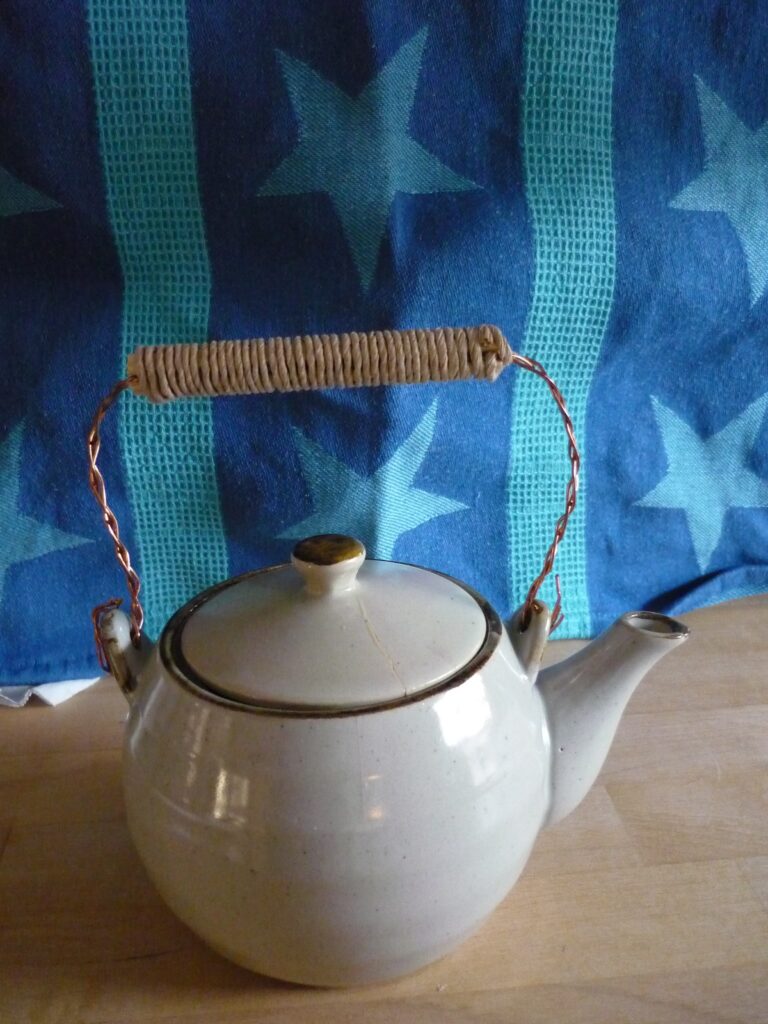
Accepting imperfection is part of what makes us human. I’ve watched this video about the beauty of mistakes about five times already. I first saw it in a great Coursera course about creativity. Neil Gaiman’s commencement address says something similar: make mistakes and make good art.
Moving from one country to another with my family, I’ve thought a lot about the broken things. There’s this desire to take the “best” things with you. New markers, clean erasers, favorite books, jeans with whole pockets and shirts with all their buttons need apply.
In a nutshell, this doesn’t work. Junk is an inescapable part of civilization. First of all, there’s that odd phenomenon that happens with every move. The things you know you left behind came with you and a few things you knew you wanted can’t be traced. But even if you don’t move, your existing, fully-functional belongings will be happy to wear out, develop holes, break, or shrink.
Presto! Fresh junk.
For example, we have a chronic teapot problem. The tile floor and the tea lite stove conspire. Yes, empty tea pots crack under the heat of a single candle. We’ve proved it repeatedly.
At the Second Hand Kaufhaus (Kaufhaus=Department Store), I bought a replacement teapot for 20 cents. It was the “right” kind for us because it was designed to have the handle on top rather than on one side of the teapot. Only it didn’t have the handle.
Small triumphs give us courage and self-esteem. We bought molding and copper wire and paper covered wire and my youngest and I made this handle. I sawed my finger a very little bit with the dull saw, but my youngest and I were very pleased with ourselves. I wrapped it and put it on the shelf as a Christmas present for my husband.
Unfortunately, the present fell to the floor before making it under the tree. When my husband opened it, the lid had broken neatly in half.
But then came a surprising reversal: He spent Christmas afternoon with Patex glue, bonding with his “new” teapot.
(Epidemiology caveat: Not sure it’s healthy to drink tea made in a glued pot. I didn’t search PubMed to find out.)
Do we need a certain number of broken things? After this experience, I wondered if a small amount of brokenness and disorganization in our lives is an invitation to participate.
It’s a kind of redemption. When we imperfectly repair a teapot, we invest ourselves in it. There’s a little glow every time we use it that says, “I saved that.”
“Craftmanship of risk” is a concept from David Pye and mentioned in the beauty of mistakes video above. When we make something new, we don’t know what’s going to happen. There’s an element of risk: maybe it won’t work. Maybe it’s all for nothing.
A broken thing is an invitation to create. It invites us to take a risk. If you have a brand new house with newly painted, perfect walls, you might have to overcome inner resistance to mar the perfection with a hole to hang up a picture. A broken thing or an imperfect thing is closer to our level.
“People are beginning to believe you cannot make even toothpicks without ten thousand pounds of capital. We forget the prodigies one man and a kit of tools can do if he likes the work enough.”
–From Barb Siddiqui’s review of David Pye’s THE NATURE AND ART OF WORKMANSHIP published in 1968.
If we like the work enough, if we find joy in it, even with its imperfections, we can make marvelous things. Broken things are a way to practice.
There’s another bonus to broken things: If we’re willing to fix them, that usually means someone wants them. That’s a built-in audience.



